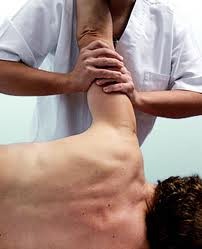PHYSIOTHERAPY AND OSTEOPATHY
require adeep knowledge on musculoskeletal machine
Physical therapy (or physiotherapy), often abbreviated PT, is a health care profession primarily concerned with the remediation of impairments and disabilities and the promotion of mobility, functional ability, quality of life and movement potential through examination, evaluation, diagnosis and physical intervention carried out by Physical Therapists (known as Physiotherapists in some countries) and Physical Therapist Assistants (known as Physical Rehabilitation Therapists in some countries). In addition to clinical practice, other activities encompassed in the physical therapy profession include research, education, consultation and administration. Definitions and licensing requirements in the United States vary among jurisdictions, as each state has enacted its own physical therapy practice act defining the profession within its jurisdiction, but the American Physical Therapy Association (APTA) has also drafted a model definition in order to limit this variation, and the APTA is also responsible for accrediting physical therapy education curricula throughout the United States of America. In many settings, physical therapy services may be provided alongside, or in conjunction with, other medical or rehabilitation services.
Osteopathy is a philosophy and an alternative medical practice which emphasizes the interrelationship between structure and function of the body and recognizes the body's ability to heal itself; it is the role of the osteopath to facilitate that process, principally by the practice of manual and manipulative therapy.[1] The American Osteopathic Association recommends using the terms osteopathic physician and osteopathic medicine to distinguish individuals trained in osteopathic medicine in the United States who have attained the degree of Doctor of Osteopathic Medicine (D.O.), a degree equivalent to that of Doctor of Medicine (M.D.), who practice the full scope of medicine and receive additional training in osteopathic manipulative medicine from individuals described as osteopaths who use osteopathy, the restricted-scope form of practice outside of North America.[2][3] Osteopaths trained outside of the US are generally limited in practice to non-invasive manual therapies, as well as providing nutritional, postural, and other health advice. Like their American counterparts, non-US osteopaths are primary contact health care practitioners.[citation needed] They are usually trained at Bachelors or Masters level in the biomedical sciences and general medical diagnosis, with the addition of osteopathic techniques, but without pharmacology and surgery. Osteopathic treatment is generally considered complementary to mainstream medicine. Medical physicians may go on to qualify as an osteopath and vice-versa.
Osteopathy is a philosophy and an alternative medical practice which emphasizes the interrelationship between structure and function of the body and recognizes the body's ability to heal itself; it is the role of the osteopath to facilitate that process, principally by the practice of manual and manipulative therapy.[1] The American Osteopathic Association recommends using the terms osteopathic physician and osteopathic medicine to distinguish individuals trained in osteopathic medicine in the United States who have attained the degree of Doctor of Osteopathic Medicine (D.O.), a degree equivalent to that of Doctor of Medicine (M.D.), who practice the full scope of medicine and receive additional training in osteopathic manipulative medicine from individuals described as osteopaths who use osteopathy, the restricted-scope form of practice outside of North America.[2][3] Osteopaths trained outside of the US are generally limited in practice to non-invasive manual therapies, as well as providing nutritional, postural, and other health advice. Like their American counterparts, non-US osteopaths are primary contact health care practitioners.[citation needed] They are usually trained at Bachelors or Masters level in the biomedical sciences and general medical diagnosis, with the addition of osteopathic techniques, but without pharmacology and surgery. Osteopathic treatment is generally considered complementary to mainstream medicine. Medical physicians may go on to qualify as an osteopath and vice-versa.
EDUARDO SANCHEZ VILLAVECCHIA

See more




